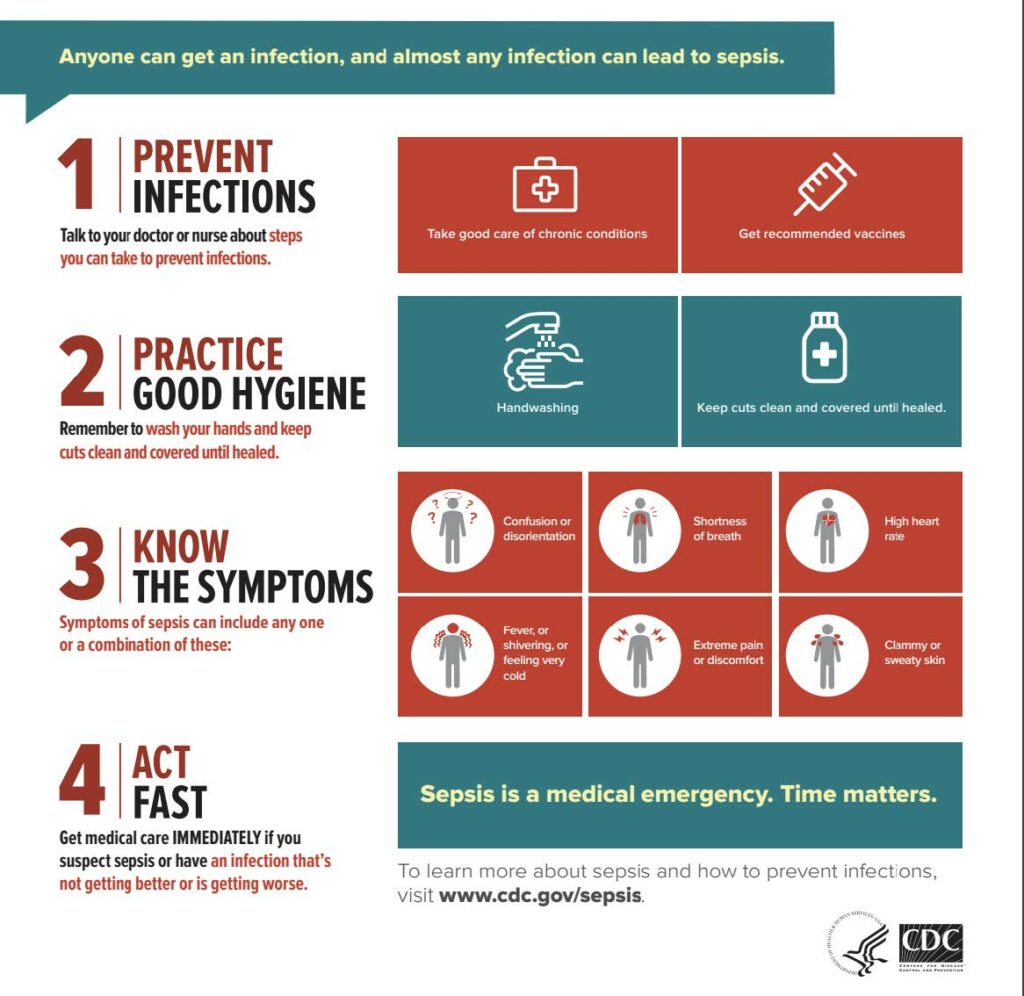Sepsis Awareness
Think back through your lifetime, and you can likely recall a time during which you experienced an infection. Virtually everyone has. We often brush off the minor ones, such as a small cut from gardening or a burn from cooking dinner, either of which could become infected. We also occasionally are burdened with the more serious ones, like appendicitis or pneumonia, which tend to force our attention. The truth is though, almost every infection can lead to sepsis, even the ones that start off as seemingly no big deal. In recognizing how common infections are, it is imperative that we understand what sepsis is, who is susceptible, and how it can be prevented and treated in order to save lives.
What is Sepsis?
Sepsis occurs when the body begins to damage its own tissues in response to an already existing infection. This can become life-threatening as the inflammation becomes widespread and blood clotting reduces blood flow. When sepsis is prolonged without treatment, it turns into septic shock. Septic shock is characterized by a severe drop in blood pressure leading to organ damage and death.

Who is at Risk?
Although anyone can get sepsis (remember, it starts with an infection, and almost everyone gets one, if not many, infections throughout their lifetime), there are certain populations that are more susceptible. These populations include the very old (sixty-five years and above), the very young, pregnant women, patients being hospitalized, and individuals with pre-existing infections and medical conditions. These individuals already have compromised or altered immune systems, making it much harder for the body to fight off infections, even ones that may seem minor. The inability to fight off the initial infection leads to widespread inflammation and blood clotting.
Sepsis is Not Rare
Though serious and frightening, sepsis is not rare. Approximately 1.7 million Americans are diagnosed with sepsis yearly. Roughly 30% of individuals diagnosed with sepsis do not survive. One in three patients in the hospital who acquire sepsis die. Though sepsis requires immediate medical care, the infection that causes sepsis starts outside of the hospital in nearly 87% of cases.
Because infections that develop into sepsis often start outside of the hospital, it is important to recognize which ones have the potential to do so and what the best prevention measures are. Sepsis is most commonly caused by bacterial infections, but can also result from fungal, viral or parasitic infections. Common types of infections that lead to sepsis include infections of the abdomen, such as appendicitis or peritonitis, infections of the central nervous system, infections of the lungs, such as pneumonia, infections of the skin, and infections of the urinary tract, such as urinary tract infections (UTIs). Some of these infections are harder to recognize than others. General sepsis prevention measures to practice at all times include good hand hygiene, keeping cuts, wounds and burns clean, staying up to date on recommended vaccines, seeking routine medical care, especially for chronic conditions, and seeking medical support for suspected infections, especially if you or a loved one fall into one of the susceptible populations.

Recognizing Signs and Symptoms
Though prevention is key, signs and symptoms of sepsis are important to recognize so you can seek immediate treatment should you experience them. They include high heart rate and low blood pressure, fever or hypothermia (low body temperature), shaking, chills, clammy skin, disorientation or confusion, and hyperventilation (fast breathing) or shortness of breath. Quick diagnosis and treatment is crucial for improving survival rates, so these signs and symptoms must be taken seriously and addressed immediately. If you or a loved one experience any of these symptoms, find in-person medical treatment or at a minimum, call your doctor with your concerns for further guidance.
Infections are common and must be taken seriously due to the risk of sepsis. Remember to practice your prevention measures and be diligent about seeking treatment should you suspect you are experiencing symptoms that could point to sepsis.
Sources:
Image 1: https://www.cdc.gov/sepsis/what-is-sepsis.html
Image 2:
Cleveland Clinic: https://my.clevelandclinic.org/health/diseases/12361-sepsis
Mayo Clinic:
https://www.mayoclinic.org/diseases-conditions/sepsis/symptoms-causes/syc-20351214


